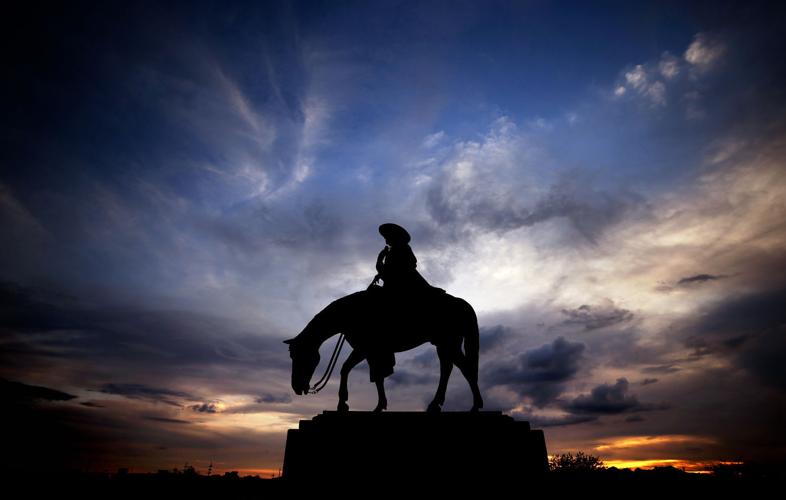Father Eusebio Francisco Kino, the 17th-century Jesuit priest who founded 21 missions in what is now Northern Sonora and Southern Arizona, moved a step closer to sainthood.
Earlier this month Pope Francis approved that Kino be declared a “venerable” person, which is two steps away from sainthood.
The pope’s formal approval recognized Kino’s life of “heroic virtue,” said Bishop Edward J. Weisenburger of the Roman Catholic Diocese of Tucson.
“Padre Kino is especially recognized as an extraordinary example of evangelization, science and respect for the dignity of the poor,” wrote Weisenburger in an email to parishioners.
The bishop said since Kino was a member of the Jesuit order with provincial headquarters in Trent, Italy, the joyous announcement affects the people of Trent and also the “faithful of the Archdiocese of Hermosillo, Mexico, the Catholic peoples of Arizona, and all who recognize the holy life of Venerable Padre Kino.”
“For Kino to be advanced to the next stage of the canonization process a miracle attributed to him is necessary. The faithful are encouraged to seek his intervention in time of need,” Weisenburger said.
Kino, who left a legacy as a missionary, explorer, cartographer, rancher and farmer, was born in 1645 in Segno, Italy, and died March 15, 1711, at age 65 in Magdalena de Kino, Sonora. In March 2011, descendants of Kino from Italy gathered outdoors in front of Mission San José de Tumacácori south of Tucson to celebrate a tricentennial commemorative Mass of Kino’s death.
His visible skeletal remains are in a crypt at La Plaza Monumental, about 50 yards from María Magdalena Church.
The Tumacácori mission was established by Kino in 1691 but later built under Franciscan missionaries. In 1700, Kino laid the foundation for a mission at the village of Bac, on the Santa Cruz River near Tucson. Mission San Xavier del Bac — also known as the White Dove of the Desert — was completed in 1797 also by Franciscan missionaries.
“I am happy to hear the news about Padre Kino being declared venerable because we have been waiting for this announcement since 2016,” said Rosie Garcia, president and founding board member of the Kino Heritage Society.
“Padre Kino was a missionary who brought Christianity to Northern Sonora and Southern Arizona. He was an advocate for social justice and he certainly deserves this honor,” she said of the sainthood process.
“A man for all seasons and all ages”
“His legacy lives on,” said Garcia. “We see it today in the Kino Border Initiative in Nogales, Sonora, a Jesuit-run shelter and an advocacy center for migrants. Truly, Padre Kino was meant to be a man for all seasons and for all ages.” She said the process to canonize Kino began in the 1960s and it started in Hermosillo, Sonora.
According to the U.S. Conference of Catholic Bishops website, after a candidate becomes venerable, the next step is blessed and then recognized as a saint.
“Venerable is a title given to a deceased person recognized formally by the pope as having lived heroic virtues,” states the site. “To be beatified and recognized as a blessed, one miracle acquired through the candidate’s intercession is required in addition to recognition of heroic virtue or martyrdom. Canonization requires a second miracle after beatification, though a pope may waive these requirements,” according to the site.
“We are very excited that this process has moved to this point acknowledging Padre Kino’s unique contributions to our history and contemporary culture as well as acknowledging his heroic sanctity,” said the Rev. Gregory Adolf, a member of the board of directors of the Southwest Mission Research Center, which promotes borderland history and also sponsors tours in Arizona and Sonora of Padre Kino missions. Adolf is also pastor of St. Andrew the Apostle Catholic Church in Sierra Vista.
Adolf, along with fellow members of the Kino Heritage Society, said the group has promoted Kino’s sainthood for over 30 years. “We have been promoting this cause through public forms, special events marking significant anniversaries of his work and inviting the public to a greater understanding of his role in the development of this region,” Adolf explained.
“Padre Kino’s work as a bridge builder between various cultures and tribes has a special relevance for us living in these borderlands,” said Adolf.
Manny Martinez, a Tohono O’odham Nation member who works closely with O’odham at Mission San Xavier del Bac, said Kino was “an ally to tribal peoples of this area. According to his writings and what we know about him, he really worked to be a bridge between Native Americans’ spirituality and the Catholic faith.”
“He went beyond the European’s perceptions of native people at that time, and he really saw us as people of the creator. He validated the first people of this land,” said Martinez. “His journey to sainthood would put him in a league of other Catholic saints who spoke up for those who did not have a voice,” he said.
“Only God knows when the process of his canonization will be complete and we can celebrate him as St. Padre Kino,” said Adolf.
“Big Jim Griffith, a well-known local folklorist and a founder of Tucson Meet Yourself, reminds us that we honor Padre Kino’s legacy every time we enjoy carne asada,” said Adolf with a chuckle, since the padre introduced wheat and beef in the late 17th century into the area.





